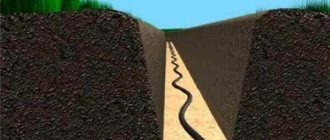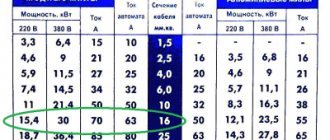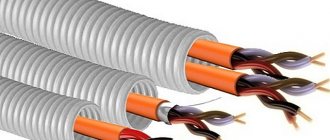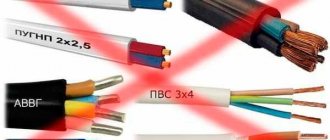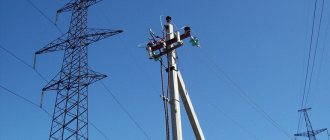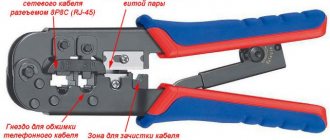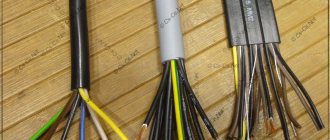When electrifying a summer cottage, any owner asks the question: which cable laying method to choose - overhead or underground. Despite the fact that running electrical communications over the air is somewhat cheaper and seems simpler than laying cables underground, it has a number of disadvantages. So, if objects are located at a decent distance from each other, you will need to install additional pillars. Having wires hanging over your head isn't fun either. Therefore, in most cases, people choose the underground method. In this article we will look at how cables should be laid in a trench, and what are the features of this work.
Rules and technology for laying underground electrical communications
It is necessary to lay the electrical cable in the ground in accordance with the requirements of the Electrical Installation Rules, having previously drawn up a laying diagram. If you can lay the route in a straight line, this will allow you to get by with less electrical wire, but this is often impossible to do. Below are the basic rules for laying cables underground:
- Try to ensure that the route does not pass near large trees; it is best that this distance is at least 1-1.5 meters.
- Do not route electrical wiring through high-stress areas. These could be parking areas, pedestrian paths or places intended for access by a sewer service vehicle. Usually they are bypassed around the perimeter, but if this is not possible, then the conductor is laid inside special protective cases, which are pieces of pipes made of HDPE or metal.
These devices are also used in places where the trench intersects with water and gas mains. A protective case is also installed where it is impossible to bury the cable at least 0.5 meters or remove large and solid objects from the route.
- When laying a trench along the foundation, it is necessary to maintain a distance between them of 0.6 m. If this requirement is not met, even a slight shift of the soil or foundation can lead to damage to the electrical line.
- The wire being laid should not be allowed to intersect with others. If this is not possible, then both cables must be placed in a protective case and one cable must be run above the other. The distance between them should be 15 cm.
If the case must have a significant length, it is welded from several pieces of pipes.
Cable trench parameters
With the earth method of pulling power cables, trenches must be cut for installation. The bottom is lined with drainage material, and the top is filled with fine-grained soil without stones and construction debris.
All the nuances are regulated by the PUE - a set of rules according to which electrical installations are installed.
How deep is the cable laid?
The laying depth depends on the power of the line. These ratios are shown in the table:
| Line power | Its depth |
| 110 kV and above (oil-filled lines). | 1.5 m |
| 1.0 m |
| 20 – 35 kV. | 0.7 m |
| At entrances to buildings (within a 5 m section), and at intersections with underground structures. | 0.5 m |
Read on our website: power supply diagram for a private house.
Other requirements for laying electrical wires in the ground
There are other rules that must be followed when laying cables underground.
- One of them is the distance from the cable to the foundation, which in the clear should not be less than 60 cm.
It is prohibited to pass the route under the foundation.
- The next rule concerns parallel laying of lines.
The distance between them depends on the voltage:
| Voltage in kilovolts (kV) | Distance between lines (mm) |
| 10 | 100 |
| 20-35 | 250 |
| 110-220 | 500 |
High-voltage cables are separated from each other by reinforced concrete slabs placed on edge.
Installation principle of oil-filled cable
- In green areas, the cable must be laid so that there is at least two meters between it and tree trunks.
By agreement with the owner of the plantings, the distance can be reduced only by laying it underground, in protective pipes. In relation to shrubs, it is enough to maintain 75 cm.
Distance to green spaces
- Lines up to 35 kV must run no closer than 1 m to sewer (including drainage) and water pipes.
- In the case of gas pipelines, this depends on the pressure in the pipes. The limit is 0.588 MPa: up to this value 1 m is maintained, above – 2 m.
Such installation can only be parallel - above and below pipelines is not permitted.
Laying options next to the heat pipe
- When the electrical route is parallel to the heat pipe, the distance between the outer walls should not be less than 2 meters. The thermal insulation of the second should be such that the temperature of the heated ground does not exceed 10 degrees for low-voltage lines, and 5 for high-voltage lines.
- If the laying is done parallel to a road or driveway, a trench is dug from the outside of the ditch or the base of the bulk cushion at a distance of 1 m. If there is a curb stone, this increases to 1.5 m.
Trench parameters for laying power lines
Having decided on the laying scheme, you need to dig a trench, while adhering to the following dimensions:
- The cable laying depth should be 0.7-0.8 m.
- If one conductor is laid, then the width of the trench used to lay the cable should be 0.2-0.3 m; if there are two or more electrical wires to be laid, it is necessary to calculate it in such a way that there is at least 0.1 m between the threads running along the bottom.
The procedure and parameters for underground cable laying in the video:
Laying cables and cable lines in Nizhny Novgorod
Cable laying cost
Name of works
Unit change
Price, rub
Manual excavation of soil (pits, pits) up to 2 m deep without fastenings with slopes, soil group 1-3 from
Mechanized earthworks from
Grounding of a single support: reinforced concrete
Installation of a spotlight (lamp), separately mounted on a bracket from
Laying cables in ready-made trenches, from:
Entry into the building from asbestos-cement pipes from
Cable and end markings
The procedure for laying cables in the ground
Having dug a trench, you need to:
- Remove roots, stones and other objects with hard and sharp edges from it, otherwise they may cause damage to the insulation during installation.
- Level the bottom and then compact it. It is not necessary to achieve perfect evenness; the main thing is that there are no sudden changes.
- Fill the bottom with sand and level it so that the layer thickness is approximately 0.1 m. Ordinary quarry sand from pits will do, but it should not contain foreign objects that could damage the electrical cable, so it must be sifted before backfilling. To ensure that there are no obvious irregularities at the bottom, this material must also be compacted after being poured into the trench.
- Inspect the insulation of electrical wires to identify possible damage. If possible, test them with a megohmmeter to check for a break (in the absence of this device, you can use a regular multimeter). If damage is found, it needs to be repaired.
- Lay the cable on the sandy bottom of the trench in light waves, without tension.
In those places where necessary, protect the conductor with covers.
- Draw a plan of the laying route, mark landmarks and distances to objects on it - this will simplify future repair work if the need arises.
- Cover the laid electrical cable on top with sand, also having previously sifted the material. After this, the sand layer (approximately 0.1 m) must be compacted with feet.
- Pour the previously excavated soil into the next layer, also removing from it objects dangerous for wiring, level and compact. The thickness of this layer should be 0.15-0.2 m.
- Then the ditch is completely covered with earth slightly above the surface level. This is necessary so that after natural compaction and subsidence of the soil, depressions do not form at the installation site.
After completing the above steps, the line can be connected to the load, having first rang it to check for integrity.
Now you know how to lay a cable in the ground in compliance with established standards. Next we will look at several nuances regarding this work.
General requirements for installation.
Control cables are used in secondary measurement, signaling, protection and automation circuits and are designed to connect individual sections of these circuits located in various parts of these devices and premises. Control cables are produced for a voltage of 660 V AC with a frequency of up to 100 Hz or 1000 V DC with copper or aluminum conductors from 4 to 61. The brands of control cables and their areas of primary application are indicated in table. 5. The decoding of the designations of the letters of the cable brands is as follows: the first letter K is the control cable; the second letter is the core insulation material; V - vinyl, R - rubber, P and Ps - polyethylene and self-extinguishing polyethylene; the third letter is the shell material: C - lead, B - polyvinyl chloride plastic, N - non-flammable rubber, St - corrugated steel; the fourth and fifth letters - the presence of protective covers: G - bare (without covers), B - armored with two steel tapes, K - armored with round wires, BG - armored with two galvanized steel tapes, BbG - armored with one galvanized steel tape. Shv - outer cover: extruded polyvinyl chloride hose over armor or corrugated steel shell, GE - general screen under a shell made of copper or aluminum foil; I cables with aluminum conductors have the letter A at the beginning of the marking (to simplify the table, it is given in parentheses), without the letter (A) - copper. When installing control cables, it is recommended to pre-harvest them in the oil extraction plant on special production lines. Table 5. Brands of control cables and their areas of primary application
| Cable brands | Advantageous Applications |
| KRSBG (A) KRNBG (A) KRNBG (A) KVVBG (A) KPVBG (A) KPSVBG | In rooms, channels, tunnels, if the cable is not subject to significant tensile forces |
| (A) KRVBGz (A) KRNBGz (A) KVVBGz (A) KPsVBGz (A) KRVBbG (A) KRNBbG (A) KVVBbG (A) KPVBbG (A) KPsVBbG | In fire hazardous rooms, channels, tunnels, if the cable is not subject to significant tensile forces |
| (A) CRNG | In fire hazardous rooms, channels, tunnels in the absence of mechanical stress on the cable |
| (A) KRVG (A) KVVG (A) KPVG (A) KPSVG | The same, in an aggressive environment |
| (A) KVBbShv (A) KPBbShv (A) KPSBbShv (A) KVStShv (A) KPStShv | In fire hazardous rooms, channels, tunnels, ground (trenches), including in aggressive environments and in places exposed to stray currents, if the cable is not subjected to significant forces |
| KVPbShv KPPbShv KPSPbShv | The same if the cable is subjected to significant tensile forces |
| (A) KRVGE (L) KVVGE (A) KPSVGE | In fire hazardous rooms, channels, tunnels in the absence of mechanical stress on the cable in an aggressive environment and the need to protect electrical circuits from the influence of external electric fields |
Continuation of the table. b
| Cable brands | Advantageous Applications |
| KRSB | In the ground (in trenches), if the cable is not subject to significant tensile forces |
| (A) KRVB (A) KRNB (A) KVVB (A) KPVB (A) KPsVB | In the ground (trenches), in aggressive environments and in places exposed to stray currents, if the cable is not subject to significant tensile forces |
Before laying, the possibility of laying the cable with cut ends is determined, and then the length of the control cable route is measured, along the length of which the cable is cut and then its ends are cut and wound on special inventory drums, which are then sent to the installation site. In the installation area, control cables are laid from inventory or directly from factory-made cable drums. Control cables with external damage detected on the sheath (dents, cracks, etc.) are not allowed for installation. When laying control cables, it is necessary to avoid splicing them, since connection (coupling) of control cables is allowed only in cases where the length of the route is greater than the construction length of the cable. The construction length of the control cable must be at least 100 m. Control cables are laid in trenches, blocks and steel pipes, along cable structures, trays and boxes. The control cables must be laid in such a way that during its further operation the occurrence of dangerous mechanical stresses and damage is excluded. So, for laying in the ground (in a trench), cables are laid with a margin of 1-2% in length (in a snake); cables laid vertically along structures are secured in such a way that the sheath is not deformed by the cable’s own weight; cables laid along horizontal structures are rigidly fixed at the end points, bending points and at connecting couplings at a distance of no more than 0.5 m on both sides of them. In places where cables with an unprotected sheath are attached, it is necessary to protect it from mechanical damage using elastic gaskets. When laying cables, the radii of the internal bending curve of the cables must be strictly observed. The multiplicity in relation to their outer diameter is given below. Control cables with impregnated paper insulation in a lead sheath: armored 15 unarmored 10 Control cables with rubber or plastic insulation in a lead sheath: armored 12 unarmoured 10 Cables in a polyvinyl chloride or rubber sheath, armored with steel profiled tape 7 Lay cables indoors on trays and in channels it is possible only without an external flammable cover, with a non-combustible shell and insulation. The outer flammable cover from the cable entering the room from the trench is removed along the entire route inside the room to the very point of exit from it flush, with the pipe or opening sealed. Laying, carrying and unwinding of the control cable can be done at positive air temperatures. If it is necessary to lay a cable at temperatures below 0°C, you must follow the recommendations of § 4. All cable metal structures on which the cables are laid must be grounded, and the metal sheaths of the control cables must be grounded at both ends. Sealing of external inputs of control cables in a structure is carried out by sealing the cable at the ends of the pipes with jute cords coated with waterproof clay to a depth of at least 300 mm at each end. When laying control cables through concrete or stone walls, they are carried out in steel or insulating tubes or through openings framed by steel boxes. The termination of the control cable cores is carried out in accordance with the recommendations of § 3 and 4; installation of control cable terminations is discussed below. Polyvinyl chloride, epoxy, lead and rubber couplings are used to connect control cables. In addition, a technology has been developed and the installation of couplings using self-adhesive tapes and heat-shrinkable tubes is being widely implemented. The technology for installing control cable couplings is not considered in this work and is given in [3].
Which conductor is best to use for installing underground electrical lines?
Installing an underground power line requires considerable effort and time. In order not to suffer in the future with constant repairs, it is better to immediately choose a high-quality wire that will be able to properly perform its function for many years. Therefore, the issue of selecting a cable that will be used for laying underground should be approached with maximum responsibility.
Using an armored cable from a reliable manufacturer, you can be sure of its proper and durable operation. However, the cost of such a conductor is quite high, and if a person cannot afford such a purchase, he uses simple wires of the NYM or VVG brand. To increase the reliability of such lines, you should use a double-walled corrugated hose DKS, into which the electrical wire is placed along its entire length.
In places where the likelihood of damage to wiring due to heavy loads is quite high, protective cases are recommended. These devices will protect the current-carrying conductors, taking on most of the load. When laying several cables, each of them must be equipped with a separate case.
Running power lines inside corrugated hoses or pipes has the added benefit of easy cable replacement. If the old wire has become unusable, it is enough to open the ends of the route and tie a new one to the end of the non-working cable. After this, the faulty conductor is pulled out, and a new one is installed in its place. Of course, this is only possible if a long period of time in the ground does not lead to the destruction of protective devices.
You can order the design of electrical networks for the following objects:
| Name of service | Unit price (RUB) | Note |
| Soil preparation and development | From 149 per m.p. | The cost depends on the composition/type of soil and the length of the trench |
| Installation of the cable in a prepared trench no more than 16 mm. sq. | From 149 per m.p. | The cost varies depending on the cable cross-section and line length |
| Installation of cable in a prepared trench from 16 mm. sq. and no more than 35 mm. sq. | From 199 per m.p. | The cost depends on the cable cross-section and line length |
| Installation of cable in a prepared trench from 35 mm. sq. and no more than 95 mm. sq. | From 269 per m.p. | The cost depends on the cable cross-section and line length |
| Installation of cable in a prepared trench from 95 mm. sq. and no more than 240 mm. sq. | From 319 per m.p. | The cost depends on the cable cross-section and line length |
| Marking cables and their ends | 49 per piece | |
| Preparation for cable sand bed | From 49 per m.p. | The cost depends on the composition and type of soil, as well as the length of the trench |
| Preparing road surfaces and cutting joints on them | From 749 per m.p. | Performed only when necessary |
| Installation of end couplings | From 4,499 per piece. | The cost depends on the quantity |
| Carrying out complex measurements of installed pair cables using direct current | 9,990 per piece | If you have more than one cable, all subsequent cables are serviced at a price of 4,000 rubles |
| Cleaning up trash on site | Negotiable | Performed only when necessary |
| Organization of places where cable lines will intersect with water pipelines, gas pipelines and other communications | From 1490 per piece. | The cost depends on the type of intersection |
| Work to restore the integrity of road surfaces | Negotiable for m.p. | The cost depends on the scope of work |
| Installation of asbestos cement pipes | From 79 per m.p. | The cost depends on the length of the line |
| Making holes in concrete for cables | 2999 per piece | |
| Preparation of layers to be compacted by tamping | From 49 per m.p. | The cost depends on the composition and type of soil, as well as the length of the trench |
| Preparation and organization of cable entry into the building | 1490 per piece | |
| Backfilling the trench with soil | From 74 per m.p. | The cost depends on the composition and type of soil, as well as the length of the trench |
| Preparation and opening of a warrant for excavation work* | 19,900 per piece | |
| Calling a specialist from the ISS to inspect the cable and trench* | 4 900 | |
| Calling tracers to apply routes to cable plans | From 4,900 per piece. | Cost depends on area |
| Laboratory testing of cable characteristics | 9900 | |
| Carrying out work on loading and unloading materials | Negotiable | |
Find out the cost of services for you!
Call
Lump connection
For installation, it is better to use a solid cable, but if it is not possible to find a piece of wire of the required length, it is better to connect the two wires on the surface of the ground, inside a sealed junction box. Such a connection is easy to maintain and, if necessary, rework. It is not recommended to place it in a homemade coupling and bury it in the ground - the contact will quickly be broken, and to restore it the trench will have to be dug out each time.
For comparison, the video shows the production of a full-fledged coupling that can be hidden underground:
Entering electrical wiring into the house
When laying a cable underground in a country house, it is necessary to take into account that when introducing a conductor into a structure (house or other building), it must not be passed under the foundation. Usually, during construction, an embed is built into the foundation strip - a piece of pipe protruding outward by a few centimeters, into which an electrical wire can be easily inserted.
If the mortgage was not made during construction work, a hole must be drilled in the foundation, into which a pipe is then inserted and fixed.
Sometimes the owners of a house with a monolithic foundation do not want to drill into the foundation to install mortgages. The solution in this case is this: the cable is inserted inside a metal pipe and rises along the wall of the structure to a certain height (usually this is the level at which the incoming cabinet is installed). At this mark, a mortgage is embedded in the wall, through which the wire is inserted into the house.
If an armored cable is used as a conductor, its sheath must be grounded. This can be done by welding or soldering an insulated wire to it, which must be set to “zero” in the electrical panel.
This should not be neglected, otherwise, if the phase breaks through, it will fall on the armored shell, touching which, the person will receive a strong electric shock, and it’s good if the matter does not end in the death of the victim. If the armor is properly grounded, then in the event of a breakdown, an automatic switch will operate, cutting off the current supply until the problem is resolved.
Features of winter laying of underground power lines
If the circumstances are such that you have to do this work in low temperature conditions, then when performing it you need to take into account several recommendations:
- Before laying the conductor in the trench, it must be warmed in a warm room. You can do this faster by using a transformer, but only if you have the skills and experience in such work.
- The warm cable must be laid in a trench. You should work quickly to prevent it from freezing. If the temperature outside is 15-20 degrees below zero, then no more than half an hour is allotted for installation. If the frost is even stronger, the power line cannot be installed.
- It is allowed to lay an underground line without heating in the following cases:
- If a high-pressure electrical cable is used and the air temperature is -5 degrees or higher.
- If a wire with simple insulation is used, and the air temperature is -7 degrees or higher.
- If a conductor with rubber or PVC insulation is used, and the air temperature is not lower than -15 degrees.
- If the conductors are insulated with polyethylene or rubber, and in addition, have an additional sheath of lead.
In this article, we examined in detail the question of how to lay a cable underground and what are the features of this procedure in various conditions. This work, despite the labor intensity, is not too difficult in technical terms. The most important thing is to take into account the requirements of the PUE and the recommendations contained in this material.
Which cables to use
If we talk about GOST, it says that it is necessary to lay armored cables in the ground, covered with a waterproofing layer on top. That is, if the allocated power is sufficiently large, it is advisable to make the underground entry into the house from the pole with an armored cable. This is AVBbShv (armored with aluminum conductors and armor made of two galvanized steel strips, covered with a protective layer on top) or VBBbShv (the same, but with copper conductors), PvBShv - also armored, but with cross-linked polyethylene insulation and the same steel strips as armor. AAShp, AAShv, AAB2l, AAP2lShv, ASShl, etc. are suitable. These types of cable products are used in lands with normal acidity.
It is better not to use cables not intended for underground installation.
Laying cables in soil with increased chemical activity - salt marshes, swamps, large amounts of construction waste, slag - requires lead armor or an aluminum sheath. In this case, you can use AABl, AAShv, AAB2l, ASB, AAPl, ASpl, AAP2l, AAShp, AVBbShv, AVBbShp, APvBbShv and others.
If you need to connect a small dacha with no electrical appliances, a bathhouse, a barn or other outbuildings (pig sty, chicken coop, etc.), you can use a regular PVC-sheathed cable, since it is quite durable and definitely airtight. NYM, SIP are often used to install lighting on the site; VVG is enough for several years. But these products are not intended for installation underground and they quickly fail.
More serious cables are, of course, more expensive, but they last much longer. If we take into account the labor intensity of installation, it is more advisable to use special cables, and these are AAShv, AAShp, AAP2l, AVVG, AABL, APsVG, ASB, AAPL, APvVG, APVG, ASPL, etc.
An armored cable has three sheaths, a regular cable has one
In the regions of the Far North, special products with increased frost resistance - PvKShp - are used for underground installation.

